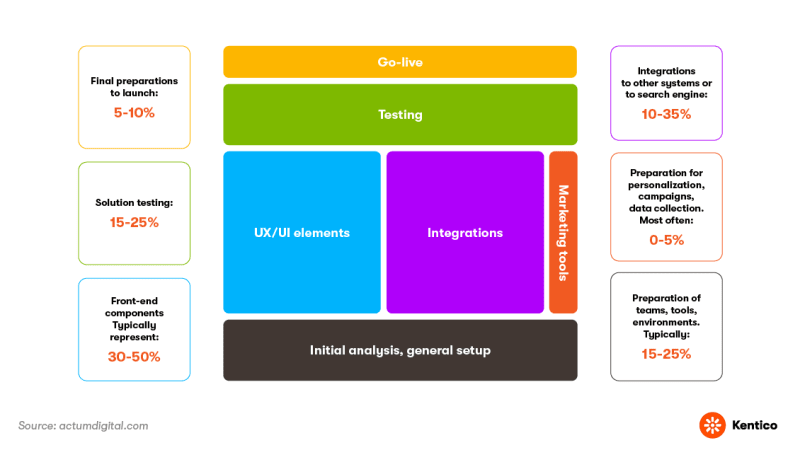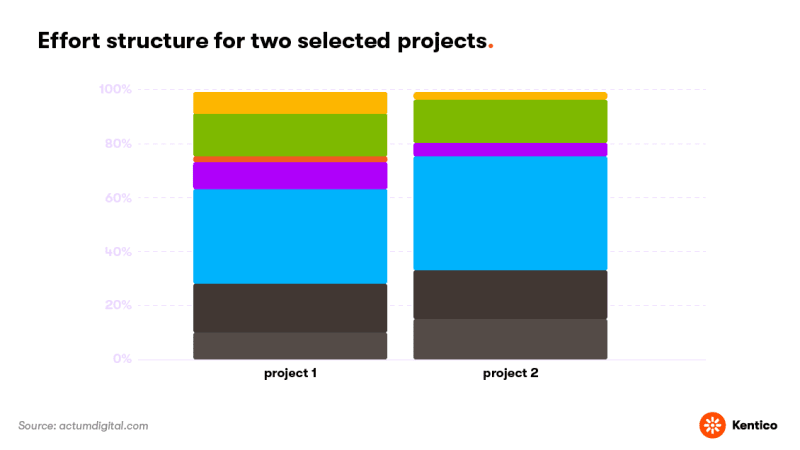Nearly every B2B company I've encountered agrees that estimating the costs of a new web solution is daunting. What drives the price? How can you stay on budget? These are the primary concerns for businesses when deciding to replace or implement new systems. Let's explore.
I'm Adam Böhm, Division Director at ACTUM Digital. Today, I will delve into some critical cost factors of Digital Experience Platforms (DXP) and Content Management Systems (CMS) for B2B companies in the SME market and small business segment.
For illustration, I've selected two projects on Kentico Xperience, one of the major platforms we use for projects at ACTUM Digital. Let's analyze their cost structures and identify the main factors contributing to the final price.
DXP/ CMS project specifics for SMEs
It's not surprising that requirements and cost structures can vary significantly when crafting a new website.
As a technology implementation partner, we work closely with businesses throughout the entire project lifecycle, enabling us to gather insights and identify common trends. Irrespective of the level of preparation done beforehand, numerous decisions are taken throughout the project. It's important to collaborate closely with the supplier and maintain a firm focus on priorities. By adhering to these measures, you can guarantee that your DXP or CMS project remains economical and provides advantageous outcomes.
What advice would you give someone embarking on a similar project?
Since we're talking about small-to-medium-sized businesses, here’s what makes their DXP/CMS implementation projects unique:
- Tailored user experience (UX)/UI: Unlike smaller entities that may use off-the-shelf components to build a website, SMEs seek a bespoke user experience that resonates with their brand identity. Therefore, they prioritize customizable components that require minimal development time.
- Seamless system integrations: SMEs aim for a harmonious digital ecosystem, integrating CRM, ecommerce, PIM, BI tools, and ERP systems to ensure a unified operational flow.
- Conversion-centric marketing: Recognizing that visibility alone isn't enough, SMEs demand robust marketing tools within their solution to increase conversion rates and transform site visitors into valuable leads and potential clients.
Effort distribution in DXP/ CMS projects
To understand the cost drivers more, let’s look at the activity structure of an average project. The graph below illustrates the expected distribution of the total implementation effort.

As shown, front-end developments and integrations can take up to 85% of the project effort, which correlates with the SMEs primary focus on UX and basic business integrations.
Across various projects, I frequently notice companies underestimating a crucial element – the general setup and initial data analysis, accounting for 15-25% of the total effort. There are two reasons why:
- The stakeholders are impatient and want to see the results as soon as possible.
- They don’t know how important this step is and rush through it to save on effort costs.
Skipping this step can lead to data migration and functionality errors, hindering future scalability of the DXP or CMS. Prioritizing this step at the initial stage of the project helps developers map the new system design and ensure systems compatibility.
Additionally, the effort required for B2B marketing tools implementation is usually very low compared to other components. This is intentional because we consider it the first production release, and marketing tools frequently do not make the cut for the Minimum Viable Product (MVP). However, omitting them could result in data gaps in later stages of the project.
How strategic focus areas shape costs
We compared two Kentico Xperience projects: a simple, effective CMS for a Czech trading company (Project 1) and a sophisticated solution for a Swiss pharma company (Project 2).

| Project 1 | Project 2 | |
| Go-live | 8% | 3% |
| Testing | 16% | 16% |
| Marketing | 2% | 0% |
| Integration | 10% | 5% |
| UI comp | 35% | 42% |
| Analysis | 18% | 18% |
| General | 10% | 15% |
Project 1 - Comprised 12 widgets and included integration into three systems with almost no business or orchestration logic. The aim was to replace the current solution and enable online marketing campaigns.
Project 2 - Included over 40 UI components and was integrated only with a CRM (Client Relationship Management) system. The goal was to re-platform to a new CMS solution that would simplify the processes for content editors and reduce high license costs.
Since both projects heavily focused on user experience improvement, we decided to have them on Azure cloud hosting. This allowed both companies to easily and cost-effectively scale up or down depending on their needs. Project 2, being a more complex solution, required more effort for implementing the UX components.
The takeaway? For successful projects, businesses need to tailor their efforts and costs to align with the project's goals and the specific needs of their industry.
Other factors that add to the cost
In addition to the primary components of the solution, there are three additional factors affecting the total cost:
Data migration
Data migration is crucial for a seamless transition and preserving your website's SEO value and performance, whether you're redesigning your website, upgrading your DXP or CMS, or merging multiple sites. While a small amount of data can be migrated fast, for large websites, migration can take weeks to months of work, resulting in higher costs.
Unused features (shelfware)
Companies use only 70-80% of the available software features in their solutions. The remaining 20-30% is classified as shelfware and does not bring any value. Business leaders are already familiar with the concept and its challenges, as they experience it firsthand within their organizations, where resistance to change is a common issue.
To control costs, carefully develop your Minimum Viable Product (MVP) before beginning the implementation process. Then, constantly discuss the priorities and align the MVP with your business objectives.
License fees
These can easily add up, so it's important to think about the Total Cost of Ownership (TCO).
There is always a choice between open-source solutions (free) and proprietary software (paid). I’ve seen many businesses trying to save on license costs of DXP and CMS solutions only to then end up purchasing other programs for campaigns or contact management, resulting in even higher TCO.
For cost savings, consider the entire ecosystem in your TCO calculations.
Starting a DXP or CMS project
So, what are the recommendations if you are about to start such a project?
1. Start with the end in mind
Define your desired outcome first. Identify essential features and omit unnecessary ones to avoid extra license costs. Engage with end-users to understand their needs and create user scenarios.
2. Pick the right platform
Choose a platform not just for its features, but for its support in efficient development, UI components, and integrations with other systems. Evaluate the platform's ecosystem compatibility, license costs, and hosting options (SaaS, cloud, etc.).
3. Go with the right vendor
Opt for a vendor with a solid track record in similar integrations, a comprehensive library of UI components, compliance with your delivery standards, readiness for production operation, and expertise in marketing features.
4. Stay involved
Regardless of how much preparation has been done upfront, many decisions are made during the project. Work closely with the vendor and be strict about priorities.
By following these steps, you can ensure that your project remains cost-effective and delivers value. Use these three go-to strategies to estimate the average DXP or CMS project cost during the presale phase.

